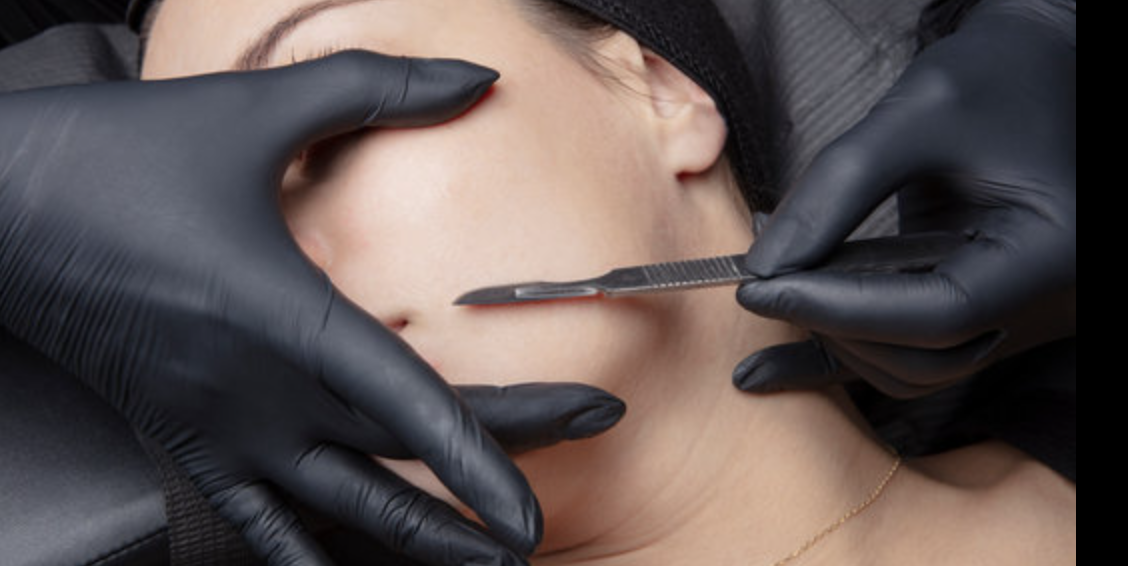
Derma Planing made the Naughty List
Buckle up Skin Squad! This one is gonna ruffle some feathers!
Ok, so who's the evil genius who convinced people that shaving their skin with a surgical blade is totally ‘different’ to using a razor to shave hair?
And who is the smarty pants who made us believe that using a knife to scrape away uneven texture and smooth out skin, was a good idea?
I’d like to meet the marketing guru who thought they could (and they did) convince thousands of people that with a surgical scalpel, shaving away hair and skin cells was the makings of a great beauty treatment.
Chatting to a non-skin-therapist friend this week, she asked me about derma planing and if she should do it. She’d heard it’s great for improving texture and giving skin a glowing, dewy finish and that it sounded like the quick fix she was looking for. (said friend also confessed to regularly going to bed without washing her face… hmmm, maybe she’s not my friend after all?? Haha!)
She immediately recoiled at my suggestion to “grab her husband’s razor and go to town on her face”, reeling at the thought of putting razor to her face. “You mean, like shaving my legs… but for my face? Oh, no thanks!”
If you've ever baulked at the idea of taking your razor and shaving the entirety of your face, then why the heck do we let a therapist in a skin clinic hold the blade? Would you lay back and lather up in a barber’s chair for the same desired effect?
Despite what the beauty industry may have told you, there is very little difference, yet we’ve all bought into this trend believing if it’s done by a ‘skin professional’ that it’s a safe and effective skin treatment.
If you’ve not heard of dermal planing, epidermal levelling or epi-blading, ignorance is bliss and I implore you to go back to your happy place. Stay there, you’re not ‘too late’ to this party, you haven’t missed a thing! (well you have, but your skin is so much better for it!)
I was introduced to Derma Planing back in 2006 when a company I worked for sent me to training for this "cutting edge" treatment (pun definitely intended!) I was dubious then and I’m even more of a sceptic now!
How does it work?
A skin therapist takes a scalpel blade, holds the skin taught and gently but briskly shaves the surface of your skin in short, feathery strokes, the blade at an angle to glide over the skin, shaving away hair and skin cells.

Sounds amazing right?
Well, it you've ever shaved your legs, you know by day two you’ve got spiky regrowth and sandpaper legs, so you can only imagine how your face is going to feel a few days after a scalpel shave.
But aside from the hair regrowth factor, here are my Red Flags:
A scalpel blade is designed to cut through skin.
Used in surgery to open up and gain access to INSIDE the body, it’s safe to say it’s pretty good at cutting through skin. Well, derma planing = same blade, different angle. Derma planing is this but kind of like a horizontal level, slicing/scraping away hair and skin cells without any control of depth or knowing if taking just the top layer.
You’re no longer just de-fuzzing and exfoliating away redundant cells but microscopically cutting away living healthy skin cells whilst relying on the steady hand of a skin therapist to not go too deep or not take off too many layers.
Unless you’re working under a powerful microscope, there’s no way of knowing the depths of “exfoliation” that are happening with a surgical blade.
Why this treatment irks me so?
Simply put, it shaves down the skins first three lines of barrier defence.
1: It shaves off your Microbiome- the invisible ecosystem that lives on the surface of our skin. straight away, we are left without our bacterial bio security system and our first layer of 'protection' is quite literally scraped off. This microbiome is vital to a healthy skin and disruption to this bacterial imbalance can lead to congestion, breakouts and an irritated skin.
2: It shaves off the Stratum Corneum- the surface layers of our epidermis, taking with it the natural moisturising factors and the multilamellar lipids that sit between our skin cells. Our skin instantly is devoid of its ability to retain moisture, leading to dehydration. (“but my therapist applies a hydrating serum” I hear you say… but why mess with a system that already does this on its own? That’s like bulldozing your roof off and replacing it with a tarpaulin.
If your skin is not feeling hydrated, smooth and glowing, consider this my not so subtle hint that you need to look a little deeper as to why? Let’s look at what your skin needs, instead of scraping off the moisture locking barrier and adding a superficial hydration.
3: By Shaving off the Stratum corneum, we expose fresh young cells (one of the selling points of this treatment) but these cells aren’t mature and able to protect us yet- they’re too young for the task of barrier protection and haven’t matured into corneocytes. They don’t yet have the right combination of ingredients to make the glue and building blocks that make our skin barrier. Basically, now we have a house without a roof. (If you’d like to read more about this, I talk a lot about the skin cell lifecycle in my book, Skinside Out )
4: It becomes an endless cycle. In order to maintain that baby bottom smoothness, you’ve got to keep shaving the epidermal layers and fuzz away. You’re inadvertently creating a skin with a regularly disrupted barrier. Our skin is always trying to create protective coating, derma planning continually shaving it off. With no end point to the treatments, you’re on the merry-go-round and it only stops if you decide to hop off.
It shaves off the vellus facial hair (the baby peach fuzz hairs) leaving regrowth within days of a treatment. One positive of this treatment is that shaving these hairs cannot turn a fluffy hair into a wiry whisker. (where a vellus hair converts to a terminal hair) but with regrowth, you will feel textured and spikey as the fluffy hair regrows, finding yourself longing for that smooth, freshly bladed feel, thus the cycle continues.
We then reach for the scalpel as soon as we feel that regrowth, meanwhile our skin cells haven’t had a chance to regenerate before they are shaved away again.
If you have an aversion to facial hair, (we’ve demonised this aesthetically displeasing facial fluff, conditioned to hate it thanks to photoshop and filters) my preferred option for temporary removal is threading. It’s less disruptive to the skin’s microbiome and stratum corneum and leaves your skin fuzz free for longer.
So, whilst Derma Planing gives instant gratification (the kind my friend was looking for), it doesn’t address the leading causes of why you were attracted to it the first place.
Congested, textured, dull, devitalised skin is caused by deeper issues that no amount of professional face shaving will resolve.
But I can assure that a skin with a disrupted barrier (like the one derma planing can give you) in the long run you’ll be rewarded with more congestion, more textural issues and a side of inflammation as your skin’s microbiome struggles to find balance.
If you’ve found yourself caught up in the derma planing vortex, there is redemption. Our skin is very forgiving and once you stop using barrier disrupting treatments and skin care, your skin will have a chance to rebuild, uninterrupted.
Stay tuned skin nerds, next week I’m on the war path with ‘slugging’ the trending DIY treatment making its way to an influencer near you.
I’ll break it down and help you understand the good, the bad and how to spot bad skin care fads.
Until then, step away from the epi-blade and no skin cells gets hurt!
Robyn
